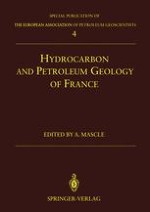1994 | OriginalPaper | Buchkapitel
Transfer Zone in the Southern Jura Thrust Belt (Eastern France): Geometry, Development, and Comparison with Analogue Modeling Experiments
verfasst von : Y. Philippe
Erschienen in: Hydrocarbon and Petroleum Geology of France
Verlag: Springer Berlin Heidelberg
Enthalten in: Professional Book Archive
Aktivieren Sie unsere intelligente Suche, um passende Fachinhalte oder Patente zu finden.
Wählen Sie Textabschnitte aus um mit Künstlicher Intelligenz passenden Patente zu finden. powered by
Markieren Sie Textabschnitte, um KI-gestützt weitere passende Inhalte zu finden. powered by
The Jura thrust belt constitutes the arcuate leading edge of the French Alps, which was developed during the Neogene and forms a conventional thin-skinned fold-and-thrust belt, whose general orientation is NNE-SSW. It consists of a thin Mesozoic cover displaced towards the NW above a regional sole thrust located in the Upper Triassic evaporitic layers, during the Late Miocene — Early Pliocene Alpine phase. During the Late Eocene and Oligocene, this area was involved in a significant extensional tectonic phase which created basement topography that has been preserved below the decollement level. These basement highs contitute potential traps, as shown by recent boreholes where oil has been tested in the southern part of the belt. Reservoirs are in the sandstones of the Buntsandstein Formation (Early Triassic) and dolomites of the Muschelkalk Formation (Middle Triassic), and potential source rocks are believed to be coal measures of Stephanian or Autunian age. In the southern part of the belt, the frontal thrust of the Jura belt is laterally linked to the frontal thrusts of the Chartreuse massif, with an offset of up to about 55 km. This area is interpreted as a complex transfer zone, which accommodates the southern termination of the belt. Balanced serial cross sections and microtectonic analysis of this zone reveal a fold-and-thrust geometry without any significant strike-slip motion along external thrusts. This particular geometry is due to a local N 50–60 ° shortening, which is strongly oblique with respect to the regional shortening of the southern Jura belt (N 100 °), and to the Chartreuse massif shortening (N 110 °). We interpret this structural setup as the result of the conjugated effect of three parameters: (1) the lateral disappearance of the basal decollement level (main parameter), (2) the influence of thickness variations in the cover between the internal and external part of the belt (indentation), and (3) the local tectonic control by previous normal faults in the basement. According to these data, analogue modeling experiments were performed and analyzed by computerized X-ray tomography in order to validate our hypothesis and to constrain the boundary conditions that produced this transfer zone and controlled its evolution.
